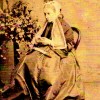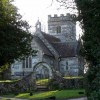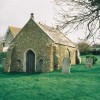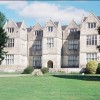For the visitor a stop at the picnic area on Batcombe Hill will be a rewarding experience. This is an area of outstanding natural beauty with views over to Somerset; on a clear day you can see as far as the Bristol Channel including Glastonbury Tor. This wide-open space provides habitats for orchids and butterflies and there is woodland, hay meadow and heathland in abundance. At the foot of the hill tucked away under the northern slopes of the Dorset Downs, is the small agricultural village of Batcombe.
The Church at Batcombe is dedicated to St. Mary Magdalene and is to be found at the far (south) end of the village. As you descend into the village you will see the tall tower and if you are familiar with the local folk tale about ‘Conjuring Minterne’ you will not be able to resist looking at the pinnacles.
In its heyday during the 19th century the parish population reached 200. Numbers declined to between 40 and 50 although we have been told by a long time resident of the village that recently there has been a “crop of children, mostly boys,” bringing the current population back to between 50 and 60.
There are indications that a church has stood on this site since the 11th century but the first recorded mention of the place tells us only that there was a rectory here in 1291 and that John Carls resigned as Rector in 1309.
Architecturally the church comprises chancel, nave and tower. The west tower was built in the first half of the 15th century and the nave and chancel built shortly after. In 1864 John Hicks restored the church and it was then that the chancel was rebuilt and the north porch added. Sacrificed during this restoration was the Minterne Chapel. The walls are of local rubble and flint with freestone dressings; the roof is tiled.
The chancel is modern except for the 15th century chancel-arch and a stone screen of similar antiquity. The pillar-piscina is 12th century and there is a fragment of stone in the middle south buttress of the chancel with pre- Norman Conquest interlacement, suggesting an earlier church at Batcombe. The modern roof incorporates some 15th century timbers.
The nave, approximately 35 feet, has in the north wall a 15th century window and doorway; there is a similar doorway opposite in the south wall which also has two similar windows. The partly restored 15th century roof of the nave is of collar-beam type with curved braces forming four-centred arches; the moulded principals and purlins have carved foliage bosses at their intersection. Beside one of the pews on the north wall is an ancient stoup.
The west tower is early 15th century and in three stages with an embattled parapet with pinnacles and gargoyles at the angles. There is a west window and on the second stage a north window of one pointed light. There is a two-light window in each of the walls of the bell chamber.
In 1827 there were four bells. One of the original bells was cracked and sold in 1864 the proceeds going someway to pay for the restoration work. A second cracked bell thought to have been cast in 1592 at Leigh by William Warre has been retained and presently rests in the intermediate chamber. The other two bells were melted down and used to cast a new bell in 1958. The new bell and the 1592 Warre bell were for some years on display in the Nave and in 1974 were stolen but fortunately recovered a couple of days later in Hampshire. The new bell now hangs in the ringing chamber and was first rung on 17th November 1974 and is still in use.
The altar cross was made by one of the parishioners in 2004 and the church has a new organ built by Brian Daniels of Crewkerne.
Within the church are memorials dating back to 1595 and include monuments to George Harris (1804), Ann his mother (1810), and John her husband (1826); John Minterne (1592); John Palmer, rector (1702-3); Thomas Beazer, rector (1734); Frances (Minterne), wife of Andrew Buckler (1648); John Minterne (1705) and Eleanor his wife (1716-7) and Ruth their daughter (1685). In the churchyard are memorials to Francis Stount (1685) and Sarah his daughter (1685-6). The oldest gravestone dates from 1680.
There are some legends about Batcombe the most intriguing being the legend of Conjuring Minterne, which tells us that one day as he was riding away from the village to Batcombe Hill he remembered he had left his book of spells open on his desk. Realising the dangers of someone dabbling with his magic book he turned back towards the village and with help from the Devil his horse leapt over the village in one gigantic stride. The horse’s hooves clipped one of the church pinnacles and it fell to the ground, Conjuror Minterne landed safely in a field near the church. It is said the pinnacle lay by the church tower for many years and it was believed it would bring bad luck to the village if it were replaced. But in 1906 it was restored and to this day it can be seen to be crooked. When he died Minterne left instructions that his body should be buried ‘neither in the church nor out of it.’ He was buried half in and half out of the Minterne Chapel.



